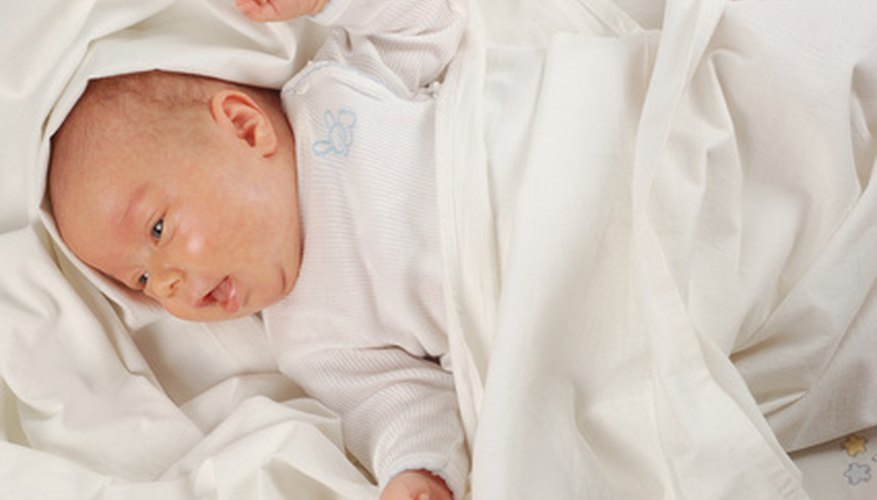Moses baskets are traditional gifts for newborns. Made for infants who are not yet old enough to turn over by themselves, these large baskets provide a safe, warm place for little ones to nap. Handmade or purchased, they are often passed on from generation to generation. Custom covers make each moses basket as unique as the babies who sleep in them.
- Moses baskets are traditional gifts for newborns.
- Made for infants who are not yet old enough to turn over by themselves, these large baskets provide a safe, warm place for little ones to nap.
Create a pattern piece for the bottom of the basket using the large sheets of paper. Lay a sheet of paper inside the basket; trace the basket's bottom on the paper and cut with scissors to create an exact pattern. Tape sheets together if needed.
Take measurements of the side walls, both top to bottom (width) and around the basket (length) on the inside of the basket. Add 20 cm (8 inches) to the width measurement only.
Lay fabric flat on a cutting surface with the right side up. Pin the paper pattern to the fabric a minimum of 5 cm (2 inches) from the edges of the fabric. With measuring tape and pencil, mark the fabric at 2.5 cm (1 inch) out from the edge of the pattern, all the way around. Remove pattern and cut out the piece, using the pencil marks as a guide. This is the bottom of the liner.
- Take measurements of the side walls, both top to bottom (width) and around the basket (length) on the inside of the basket.
- With measuring tape and pencil, mark the fabric at 2.5 cm (1 inch) out from the edge of the pattern, all the way around.
Transfer the width and length measurements for the side pieces to the fabric. Using scissors, cut out one continuous piece to create the side of the liner.
- Transfer the width and length measurements for the side pieces to the fabric.
- Using scissors, cut out one continuous piece to create the side of the liner.
Pin the ends of the side piece together with right sides of fabric touching. Using a sewing machine (on straight-stitch setting), sew a 6 mm (1/4 inch) seam. This will form the inside liner for the walls of the basket.
Pin the bottom liner and side liner together with right sides of fabric facing each other. Pin every 2.5 cm (1 inch) all the way around to keep the fabric from shifting. If necessary, make small pleats in the material to create a proper fit. Using the sewing machine, sew a 1.3 cm (1/2 inch) seam all the way around, removing pins as you go.
Create the tunnel for the elastic on the outside edge of liner, by turning the liner inside out and folding over 1.3 cm (1/2 inch), twice. Pin in place and use the sewing machine to sew along the inside edge, leaving a 1.3 cm (1/2 inch) wide opening to insert the elastic.
- Create the tunnel for the elastic on the outside edge of liner, by turning the liner inside out and folding over 1.3 cm (1/2 inch), twice.
Insert a safety pin into one end of the elastic and close the pin. Insert the safety pin in the tunnel and work it through until it appears at the opposite end of tunnel.
Adjust the elastic to fit the Moses basket. Place liner inside the basket and fold it over the top edge. Holding both ends of the elastic, pull it tight enough to be slightly snug, but not so tight as to collapse the sides of the basket. Join the elastic with the safety pin, and remove the liner from the basket.
Complete the liner by sewing the ends of elastic together where they are joined by the safety pin. Remove the safety pin and trim the excess elastic. Sew the opening in the fabric closed. Trim any hanging threads and place liner in basket. Place a pad or a mattress in the basket.
TIP
Rectangular openings can be created to accommodate baskets with handles. Cotton or baby flannel fabrics are recommended for softness and easy cleaning. Create coordinating sheets to fit pad or mattress to complete the custom look.
WARNING
Use only fabrics recommended for infant use. Wash and dry the fabric before cutting to avoid issues with shrinkage.
